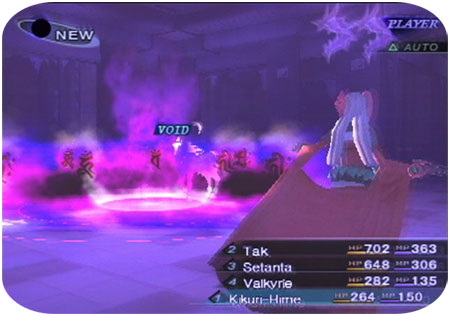
(Original image source: Atlus.)
Like most RPGs, Shin Megami Tensei III: Nocturne can be frustrating in the beginning. The player has yet to learn the nuances of the game mechanics, the player character is initially fragile, and combat encounters are dicey affairs due to the unknown threat level of every strange new foe.
In Nocturne’s case, this is compounded by the way the game handles random encounters. Precious few areas in the game are free of them and the player will rarely be able to take more than a few steps in any direction before being set upon. What might otherwise be a 50-hour gaming experience is dragged out to twice that amount of time because of this. These constant interruptions are merely irritating when trying to get somewhere but are downright aggravating when faced with one of the many puzzles in the game. It’s hard to concentrate on solving a logic puzzle when you’re constantly being harassed by Succubi.
The main problem here is the random mobs in this game are invisible on the main game screen with the only indicator of an impending attack being the glow of the enemy radar. It starts off blue to indicate a safe area, slowly changes colours before finally blinking red to indicate an imminent and entirely unavoidable battle. You may attempt to escape battles once they’ve begun but there’s no way of avoiding them altogether.
(Persona 3, a 2006 design from Atlus, handled this better. Mobs in Tartarus, the main dungeon of the game, are visually represented as shadowy blobs which players could choose to hunt or sneak past.)
While players may come to loathe Nocturne’s approach to encounters, there are some advantages.
From a developer’s standpoint, the benefit is it requires fewer resources. Atlus’s games may have a certain style to them but they are clearly not on the same budgetary level of Square Enix titles. While the latter’s franchises are wont to overwhelm the player’s senses with a Sturm und Drang flash and bombast mode of presentation, Atlus games have had to make do with less. It’s telling that even the newer Persona games represent mobile mobs on the main game screen as mere blobs with minimal animation.
The advantage for players is they have the option of raising or lowering the encounter rates through the use of specific items and skills. Players may want to raise the encounter rate when levelling up the player character and his retinue of demons, and lower it to get to destinations as quickly as possible.
To further reduce the drudgery of these encounters, battles can be automated. However, given that even grunts in this game may possess insta-kill skills, it’s probably best not to go full Auto unless the party is equipped to handle worst case scenarios. There’s nothing quite like losing an entire session’s worth of progress because of an unexpected Expel or Death skill.
